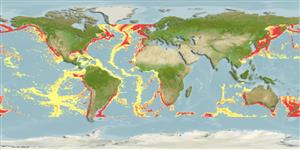Actinopterygii (ray-finned fishes) >
Notacanthiformes (Halosaurs and deep-sea spiny eels) >
Notacanthidae (Deep-sea spiny eels)
Etymology: Notacanthus: Greek, noton = back + Greek, akantha = thorn (Ref. 45335). More on author: Bloch.
Environment / Climate / Range
Ecology
Marine; benthopelagic; depth range 125 - 3285 m (Ref. 58426), usually 125 - 1000 m. Deep-water; 2°C - 4°C (Ref. 56467), preferred ?; 61°N - 50°S, 180°W - 180°E
Worldwide except in tropical waters (Ref. 27363). North Atlantic: Gulf of Mexico and Cape Blanc, Mauritania north to Davis Strait, Canada and Iceland. South Atlantic: off South Africa. Southeast Pacific: off Chile. Eastern Indian Ocean: Australia (Ref. 7300). Southwest Pacific: New Zealand (Ref. 5755).
Size / Weight / Age
Maturity: Lm ? range ? - ? cm
Max length : 120 cm TL male/unsexed; (Ref. 4449)
Benthopelagic (Ref. 58302) and epibenthic (Ref. 58426). Not uncommon in depths around 180 m off Iceland and Greenland. Individuals with nearly ripe eggs have been found in late autumn off Iceland. Mostly found at depths well below 200 m, but enters slightly shallower water on Grand Banks in Canada (Ref. 7251). Feeds primarily on sea anemones (Ref. 4449).
Life cycle and mating behavior
Maturity | Reproduction | Spawning | Eggs | Fecundity | Larvae
Sulak, K.J., 1990. Notacanthidae. p. 133-135. In J.C. Quero, J.C. Hureau, C. Karrer, A. Post and L. Saldanha (eds.) Check-list of the fishes of the eastern tropical Atlantic (CLOFETA). JNICT, Lisbon; SEI, Paris; and UNESCO, Paris. Vol. 1. (Ref. 4449)
IUCN Red List Status (Ref. 115185)
CITES (Ref. 94142)
Not Evaluated
Threat to humans
Harmless
Human uses
Fisheries: of no interest
More information
Common namesSynonymsMetabolismPredatorsEcotoxicologyReproductionMaturitySpawningFecundityEggsEgg development
ReferencesAquacultureAquaculture profileStrainsGeneticsAllele frequenciesHeritabilityDiseasesProcessingMass conversion
Tools
Special reports
Download XML
Internet sources
